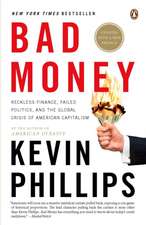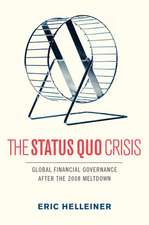Innovation and Its Enemies: Why People Resist New Technologies
Autor Calestous Jumaen Limba Engleză Hardback – 25 aug 2016
| Toate formatele și edițiile | Preț | Express |
|---|---|---|
| Paperback (1) | 175.85 lei 31-37 zile | |
| Oxford University Press – 21 mar 2019 | 175.85 lei 31-37 zile | |
| Hardback (1) | 269.59 lei 10-16 zile | |
| Oxford University Press – 25 aug 2016 | 269.59 lei 10-16 zile |
Preț: 269.59 lei
Preț vechi: 333.08 lei
-19% Nou
Puncte Express: 404
Preț estimativ în valută:
51.58€ • 53.86$ • 42.69£
51.58€ • 53.86$ • 42.69£
Carte disponibilă
Livrare economică 04-10 martie
Preluare comenzi: 021 569.72.76
Specificații
ISBN-13: 9780190467036
ISBN-10: 0190467037
Pagini: 432
Dimensiuni: 213 x 147 x 36 mm
Greutate: 0.54 kg
Editura: Oxford University Press
Colecția OUP USA
Locul publicării:New York, United States
ISBN-10: 0190467037
Pagini: 432
Dimensiuni: 213 x 147 x 36 mm
Greutate: 0.54 kg
Editura: Oxford University Press
Colecția OUP USA
Locul publicării:New York, United States
Recenzii
It takes one of the leading lights on innovationCalestous Jumato truly understand the forces that oppose it. Just as technologic change is reaching peak velocity, this extraordinary work provides a systematic, scholarly, and surgical dissection of what can hold us back.
An insightful book that addresses one of the paradoxes of our time, namely why generations that have benefited so much from innovation are so resistant to it. Drawing on a fascinating diversity of historical examplescoffee, electricity, refrigeration, farm mechanization, genetic modificationProfessor Juma discusses how innovation occurs, the role of experts and why skepticism and confusion are often inevitable. A must-read for everyone involved in technology development and policy.
An outstanding treatise on how new technologies are created and why they are so often not initially accepted by society. Innovation and Its Enemies is filled with wonderful stories that go through innovations ranging from cell phones to coffee to the light bulb. I loved reading it.
Calestous Jumas book provides a very enjoyable insight into the attitudes of society and individuals to innovation over the centuries. Its highly accessible style provides the reader with great historical nuggets arising from the introduction of coffee and printing through to reactions invoked when margarine and transgenic crops were launched. The conclusions are supported by amazing facts and detailsI didnt want to put the book down because there were so many instances when I thought I knew the full story only to find new twists and turns.
We all know how difficult it can be to accept truly revolutionary innovations. Professor Juma illustrates the difficulties faced by the innovators with a few case histories and provides some guidelines for avoiding many of the difficulties. One strong lesson is that engaging with the consumers, usually the general public, at an early stage is a very good idea. Another clear lesson is that different stakeholders react very differently to innovation, especially when it seems it might seriously disrupt existing businesses or traditional social structures. A must read for anyone who wishes to engage in such disruption themselves.
We live among so many innovations that we tend to forget that before their acceptance, there tends to be resistance among the public, or by people whose livelihoods are threatened by them. Coffee, printing and refrigeration are among the innovations which have become so widespread that we may be amazed to read about their troubled histories. Other newer innovations, including genetic modification of plants and animals are still in the midst of public scrutiny. Professor Jumas book is a very well-researched account of innovation and its enemies, not to be missed by scholars and the public, both for historical perspectives and readiness for future innovations.
Knowledge is a continuum; thus Mendelian genetics has now given way to molecular genetics. Innovation and Its Enemies gives an excellent account of the continuity of innovation and the impediments faced in getting new ideas accepted. The author has given excellent examples of the conflict between the old and the new in scientific progress. A recent example is genetic modification. This book is a timely one since scientific knowledge is progressing at such a rate that often the new technologies are viewed with suspicion. We owe a deep debt of gratitude to Dr. Calestous Juma for his labor of love for the progress of human wellbeing through scientific innovations.
This is a good read and an invaluable reference work for those working on new technologies, especially those needed to meet the grand challenges of the 21st century. Calestous Jumas detailed analysis of how innovations have been accepted or resisted is complete and fascinating. Many view resistance to advances such as GM foods and mobile phones as a modern phenomenon related to recent advances in science. Calestous explains that innovations have in fact been resisted for centuries but goes on to explain how this resistance can, and has been, overcome.
Drawing from an insightful study of over 600 years of technological history, Innovation and Its Enemies is an excellent analysis of forces that oppose new innovative products and services like incumbent industries, fear of change and risk, and socioeconomic uncertainties resulting from the perception of benefiting only a few and costing the majority. A must read for entrepreneurs, policy framers and academicians.
This stimulating history of innovation looks beyond just the obvious successes and failures. Between the high and lows lies a large territory where adoption might go either way and Jumas insight is to see how the appropriate deployment of political capital and a deeper understanding of how the average citizen can confuse hazard and risk can make crucial differences to outcomes. Scientific and political leaders need this book.
Superb! Magnificent! A must read to anyone holding public office. Having overcome obstacles as president of the Dominican Republic in building the metro system of Santo Domingo, I found in Professor Calestous Jumas book useful theoretical insights into the understanding of why resistance occurs when introducing innovation in the public sphere.
Innovation and its Enemies is a wonderful read. The style is lucid. The tone is lively. Professor Juma examines why people resist innovation, and argues that controversies result from the tension between the need to innovate and the pressure to maintain order. Although he discusses a profound socio-historical issue, his titles are very creative and eye-catching, and his use of case studies from history brings the information closer to the general reader. This is truly a great book and a fascinating read!
This book vividly illustrates, in an anthropological manner, nine stories of innovation and how each impacted human behavior and overcame its enemies, or incumbent socio-economic, cultural and political values, through the lens of Coffee in the 15th-17th centuries, Printing of Bible and Koran in the 15th-16th centuries, and recently, genetically engineered crops and salmon. As the world of globalization becomes more fragmented and fragile, new forms of innovation have sprung up to the challenges of climate change, biodiversity, energy, aging society, to name a few. Further, innovation is entering a new stage, with faster, lower-cost and more democratic approaches, e.g., Whatsapp, Uber, Airbnb. This book also gives direction for ways innovators and scientists can face enemies in the future.
Calestous Jumas Innovations and Its Enemies is a great read that uniquely outlines the history of society resisting new technologies and innovative ideas that caused social and economic distribution. We have dwindling resources on our planet and continue to do irrevocable harm to our climate. Add the ever growing population demanding the benefits of wealth including health and food excess and it is clear we are heading for disaster. Juma discusses how laws, business and social institutions and scientific communication need to adapt as the risk of doing nothing may outweigh the risks of innovating.'
An insightful book that addresses one of the paradoxes of our time, namely why generations that have benefited so much from innovation are so resistant to it. Drawing on a fascinating diversity of historical examplescoffee, electricity, refrigeration, farm mechanization, genetic modificationProfessor Juma discusses how innovation occurs, the role of experts and why skepticism and confusion are often inevitable. A must-read for everyone involved in technology development and policy.
An outstanding treatise on how new technologies are created and why they are so often not initially accepted by society. Innovation and Its Enemies is filled with wonderful stories that go through innovations ranging from cell phones to coffee to the light bulb. I loved reading it.
Calestous Jumas book provides a very enjoyable insight into the attitudes of society and individuals to innovation over the centuries. Its highly accessible style provides the reader with great historical nuggets arising from the introduction of coffee and printing through to reactions invoked when margarine and transgenic crops were launched. The conclusions are supported by amazing facts and detailsI didnt want to put the book down because there were so many instances when I thought I knew the full story only to find new twists and turns.
We all know how difficult it can be to accept truly revolutionary innovations. Professor Juma illustrates the difficulties faced by the innovators with a few case histories and provides some guidelines for avoiding many of the difficulties. One strong lesson is that engaging with the consumers, usually the general public, at an early stage is a very good idea. Another clear lesson is that different stakeholders react very differently to innovation, especially when it seems it might seriously disrupt existing businesses or traditional social structures. A must read for anyone who wishes to engage in such disruption themselves.
We live among so many innovations that we tend to forget that before their acceptance, there tends to be resistance among the public, or by people whose livelihoods are threatened by them. Coffee, printing and refrigeration are among the innovations which have become so widespread that we may be amazed to read about their troubled histories. Other newer innovations, including genetic modification of plants and animals are still in the midst of public scrutiny. Professor Jumas book is a very well-researched account of innovation and its enemies, not to be missed by scholars and the public, both for historical perspectives and readiness for future innovations.
Knowledge is a continuum; thus Mendelian genetics has now given way to molecular genetics. Innovation and Its Enemies gives an excellent account of the continuity of innovation and the impediments faced in getting new ideas accepted. The author has given excellent examples of the conflict between the old and the new in scientific progress. A recent example is genetic modification. This book is a timely one since scientific knowledge is progressing at such a rate that often the new technologies are viewed with suspicion. We owe a deep debt of gratitude to Dr. Calestous Juma for his labor of love for the progress of human wellbeing through scientific innovations.
This is a good read and an invaluable reference work for those working on new technologies, especially those needed to meet the grand challenges of the 21st century. Calestous Jumas detailed analysis of how innovations have been accepted or resisted is complete and fascinating. Many view resistance to advances such as GM foods and mobile phones as a modern phenomenon related to recent advances in science. Calestous explains that innovations have in fact been resisted for centuries but goes on to explain how this resistance can, and has been, overcome.
Drawing from an insightful study of over 600 years of technological history, Innovation and Its Enemies is an excellent analysis of forces that oppose new innovative products and services like incumbent industries, fear of change and risk, and socioeconomic uncertainties resulting from the perception of benefiting only a few and costing the majority. A must read for entrepreneurs, policy framers and academicians.
This stimulating history of innovation looks beyond just the obvious successes and failures. Between the high and lows lies a large territory where adoption might go either way and Jumas insight is to see how the appropriate deployment of political capital and a deeper understanding of how the average citizen can confuse hazard and risk can make crucial differences to outcomes. Scientific and political leaders need this book.
Superb! Magnificent! A must read to anyone holding public office. Having overcome obstacles as president of the Dominican Republic in building the metro system of Santo Domingo, I found in Professor Calestous Jumas book useful theoretical insights into the understanding of why resistance occurs when introducing innovation in the public sphere.
Innovation and its Enemies is a wonderful read. The style is lucid. The tone is lively. Professor Juma examines why people resist innovation, and argues that controversies result from the tension between the need to innovate and the pressure to maintain order. Although he discusses a profound socio-historical issue, his titles are very creative and eye-catching, and his use of case studies from history brings the information closer to the general reader. This is truly a great book and a fascinating read!
This book vividly illustrates, in an anthropological manner, nine stories of innovation and how each impacted human behavior and overcame its enemies, or incumbent socio-economic, cultural and political values, through the lens of Coffee in the 15th-17th centuries, Printing of Bible and Koran in the 15th-16th centuries, and recently, genetically engineered crops and salmon. As the world of globalization becomes more fragmented and fragile, new forms of innovation have sprung up to the challenges of climate change, biodiversity, energy, aging society, to name a few. Further, innovation is entering a new stage, with faster, lower-cost and more democratic approaches, e.g., Whatsapp, Uber, Airbnb. This book also gives direction for ways innovators and scientists can face enemies in the future.
Calestous Jumas Innovations and Its Enemies is a great read that uniquely outlines the history of society resisting new technologies and innovative ideas that caused social and economic distribution. We have dwindling resources on our planet and continue to do irrevocable harm to our climate. Add the ever growing population demanding the benefits of wealth including health and food excess and it is clear we are heading for disaster. Juma discusses how laws, business and social institutions and scientific communication need to adapt as the risk of doing nothing may outweigh the risks of innovating.'
Notă biografică
Calestous Juma, a national of Kenya, is an internationally-recognized authority on the role of science, technology and innovation in economic development. He is Professor of the Practice of International Development and Director of the Science, Technology, and Globalization Project at Harvard Kennedy School. He directs the Agricultural Innovation in Africa Project funded by the Bill and Melinda Gates Foundation and serves as Faculty Chair of Harvard's Innovation for Economic Development executive program. Juma is a former Executive Secretary of the UN Convention on Biological Diversity and Founding Director of the African Centre for Technology Studies in Nairobi. He was Chancellor of the University of Guyana and has been elected to several scientific academies including the Royal Society of London, the US National Academy of Sciences, the Academy of Sciences for the Developing World, the UK Royal Academy of Engineering and the African Academy of Sciences.

















